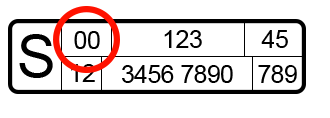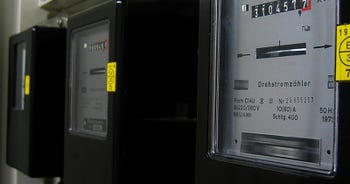What is a half-hourly meter and how will MHHS affect your business?
Half-hourly meters send automatic meter readings to your supplier every 30 minutes. If your business has a high electricity demand, you'll need to install half-hourly meters at your premises. If you have a smart meter, you'll probably be switched to half-hourly metering as part of the Market-wide Half-Hourly Settlement (MHHS) programme.
We'll get into that in more detail now, along with the pros and cons of half-hourly metering, the legal requirements for your business, how the type of electric meter you need depends on the amount of energy you use, as well as how and when you use it, and more.

Five-point summary
- Half-hourly meters automatically record and transmit electricity usage data every 30 minutes, ensuring businesses are billed based on actual consumption rather than estimates, which reduces the risk of overpaying and provides greater budget certainty.
- Installation of half-hourly meters is mandatory for businesses with a peak demand of 100 KVA or more in any half-hour period, while those with demand above 70 kVA (kilo Volt-Amperes) can opt in for the benefits of detailed monitoring.
- Market-wide Half-Hourly Settlement (MHHS) is a UK energy market reform that will require all electricity usage to be settled using half-hourly (every 30 minutes) data. This begins in September 2025 and should be complete by May 2027.
- The detailed, real-time consumption data from these meters enables businesses to analyse usage patterns, optimise energy efficiency, and potentially reduce costs and carbon footprint by identifying high-demand periods and implementing efficiency measures.
- Regulations like Ofgem’s P272 have expanded the use of half-hourly settlement to more businesses, ensuring accurate billing and supporting grid management. These meters are most common in energy-intensive sectors such as manufacturing, warehousing, and large retail.
What is a half-hourly meter?
Half-hourly meters automatically send business electricity readings to your supplier every 30 minutes. Businesses with a peak electricity demand of 100KVA (80 kWh) or more every half hour are legally required to have one installed. If your business has a peak electricity demand of no lower than 70 KVA (56 kWh) every half hour, then installation is optional.
A half-hourly meter sends regular, accurate readings to your supplier to help ensure you only pay for the energy you use. This means there should be little chance of underpaying or overpaying - both issues that can arise with estimated billing.
Automated readings also save you the time and hassle of taking and supplying regular meter readings - a real headache if you need to do this for multiple meters across multiple sites. and could also help cut your bills as you’ll be accurately charged for the power you use.
If you have a smart meter, you’ll likely be moved to half-hourly metering under the Market-wide Half-Hourly Settlement (MHHS) programme. Migration to MHHS is due to begin in October this year for both domestic and non-domestic meters.
What is Market-wide Half-Hourly Settlement (MHHS)?
Market-wide Half-Hourly Settlement (MHHS) is a UK energy market reform that will require all electricity usage to be settled using half-hourly (every 30 minutes) data.
Led by Ofgem, the energy regulator, MHHS transforms how suppliers pay for electricity by matching what customers actually use every half hour, instead of using estimates from manual readings or daily smart meter data.
For context, energy settlement is the process used to compare and financially balance the amount of electricity suppliers buy from generators with what customers actually use. This helps ensure customer bills are accurate and suppliers are compensated or charged for any shortfalls or excesses in their contracted electricity.
The MHHS rollout begins in September. This will involve the replacement of older meter types with modern smart meters that transmit half-hourly readings.
If no smart meter is fitted, the half-hourly settlement will be done using data based on annual usage, property type and usage intensity.
For more detailed information, check out our guide to Market-Wide Half-Hourly Settlement (MHHS) and what it means for your home and business.
What is the difference between half-hourly and non-half-hourly meters?
The main difference is that while standard business energy meters require you to make a note of your reading and send it to your supplier, usually once a month, half-hourly meters automatically give your supplier your latest reading at 30-minute intervals.
Even smart meters for business will only provide monthly meter readings unless you ask your supplier to adjust the settings.
What are the benefits of half-hourly meters?
Also known as HH meters, these devices provide regular automatic readings and offer the following benefits:
- Automatic readings ensure you’re billed as accurately as possible, reducing the chance of incorrect charges.
- Like smart meters for business, HH meters give detailed data. This allows you to track the impact of any energy efficiency measures you’ve introduced and monitor your energy usage more closely.
- More accurate meter readings make it easier for Bionic’s tech-enabled experts to find you a better business energy deal at renewal. We can more easily use archived energy usage data to negotiate your next contract.
- Monitoring your energy usage with half-hourly meters can help you implement energy-saving measures, which can cut your costs and carbon footprint.
What are the drawbacks of half-hourly meters?
Although HH meters can be a useful addition to your energy management set-up, they're not without some slight drawbacks, including:
- While half-hourly meters can help you save through accurate billing, they can come with higher standing charges due to the cost of maintaining high-capacity connections. Businesses are also responsible for Meter Operator (MOP) and Data Collector (DC) charges, and may incur additional fees such as excess capacity charges if they exceed their agreed supply limits
- The process of switching suppliers can be more complex for businesses with half-hourly meters due to the data and contractual requirements involved. At Bionic, we offer a bespoke comparison and switching service for large and industrial businesses with high energy demands.
- The detailed consumption data offered by half-hourly meters can be confusing if you don't have the proper tools or expertise to make the most of it. This could see your business miss out on efficiency opportunities.
Does your business need a half-hourly meter?
If your business has a peak electricity demand of 100KVA or more every half hour, then having a half-hourly meter is mandatory, and you’ve no option but to have one installed (if you haven’t already).
If your peak electricity demand is no lower than 70 KVA every half hour, then the installation is optional. Some businesses with usage at the lower level opt to have an HH meter because of its energy-monitoring benefits.
If you’re moving business premises, you can find out if there’s already a half-hourly meter installed by checking if there’s a “00” in the top corner next to the S (as shown below).

You’ll also need a Meter Operator (MOP) Agreement for the maintenance of your half-hourly meter, as well as a Data Collector (DC) to process your half-hourly readings.
What businesses have half-hourly meters?
Half-hourly meters are only available to businesses that have a peak electricity demand of at least 70 KVA every half hour. This means these meters are most often used by the following types of businesses:
- Department stores
- Distribution centres
- Factories
- Manufacturing
- Warehouses
How to read a half-hourly meter
Automated meter reading (AMR) is one of the key features of a half-hourly meter, which means you don’t actually need to know how to read it. If you want or need to read it manually for any reason, the way you take a reading will depend on the type of meter you have. If you have a smart meter, this should come with a separate display that shows you all the information you need.
How much does half-hourly electricity cost?
Suppliers will sometimes drum up business with high-energy consumers by offering them lower unit rates - measured in kilowatt-hours (kWh), the unit rate is the amount you’re charged for the electricity you use.
When you sign up for a fixed-rate deal, the unit rate is fixed, but your bills will still vary, depending on the amount of fuel you use.
Other fixed half-hourly meter charges on your bill include the standing charge - a daily amount charged to cover installation and maintenance of the electricity distribution network, and the distributor’s administration cost - and VAT, which is charged at 20% for high-energy consumption businesses.
To find out how much energy a business like yours should be using, check out the Bionic guide to average energy consumption.
You can see the latest large energy business rates in our guide to industrial and large business energy prices.
You’ll also have to pay availability charges for electricity to cover investment and maintenance of the electricity network. This is charged per unit according to the agreed capacity for that site.
It’s also worth bearing in mind that while consumption volume and the type of tariff you’re on will have an impact on energy costs, rates will also vary according to the location of your business.
What is P272? Is your meter affected by it?
P272 is an Ofgem regulation that affects the way electricity suppliers settle electricity consumption for businesses within a specified energy use. It means that meters with 05-08 profiles are now settled half-hourly and have been reprofiled as half-hourly meters.
If the S number on your Meter Point Administration Number (MPAN) is 05, 06, 07 or 08, then your meter profile will change to 00 and readings will be taken every half hour, as part of P272.
For more information, check out the Bionic guide to large business and industrial energy.
How will a half-hourly meter affect your business energy bills?
A half-hourly meter will make sure that your business is billed accurately for the energy it uses. But, as a high-consumption business, you might also benefit from cheaper rates when using a half-hourly meter. This is why it's important to compare suppliers and find a deal that suits the needs and budget of your business.
Can you have a prepayment meter with a half-hourly meter?
In most cases, you can’t have a prepayment meter with a half-hourly meter. There are several reasons why, including:
- Half-hourly meters are designed for larger businesses with high electricity demand (typically using over 100 kVA in any 30-minute period). These meters automatically send detailed usage data to your supplier every 30 minutes and are usually linked to bespoke, contract-based billing arrangements.
- Prepayment meters are intended for smaller businesses and work on a pay-as-you-go basis. They’re not compatible with the complex billing and data reporting systems required for half-hourly metering.
If your business qualifies for half-hourly metering, you’ll usually need to pay for energy in arrears through a contract with an energy supplier.
If you’re struggling to pay your energy bills or looking for more control over energy spending, there may be other options, such as flexible payment plans.
But prepayment meters are included in the MHHS rollout. If you have a meter class 01 or 02 (domestic), 03 (which covers most small businesses) or 04 (non-domestic time of use), then you will qualify for half-hourly settlement under MHHS, even if you're on a prepayment meter. Your energy supplier must ensure the PPM is a compatible smart meter in prepayment mode and that the data can be exchanged with MHHS systems.
How to compare UK half-hourly electricity tariffs
If you’re on a half-hourly meter, you’ll still want to make sure you’re on the best possible deal to avoid overpaying for energy. The simplest way to compare deals to find the best half-hourly electricity quote for your business is to speak to the tech-enabled experts at Bionic.
It only takes a matter of minutes for us to find our best deals. And because we only compare deals from our panel of trusted suppliers, you can be sure you’ll also get quality service alongside great rates.
To start your electricity price comparison, pop your postcode in the box on the right or speak to Bertie. Our live chat is available from 9 am to 5 pm, Monday to Friday.








